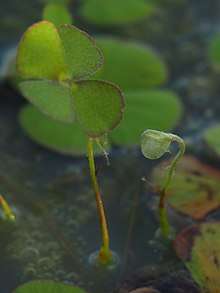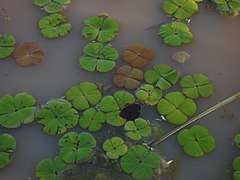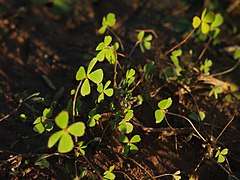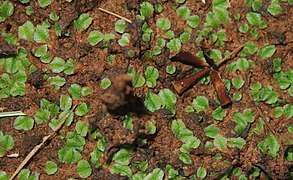Marsilea drummondii
| Marsilea drummondii | |
|---|---|
 | |
| M. drummondii leaf and fiddlehead | |
| Scientific classification | |
| Kingdom: | Plantae |
| Division: | Pteridophyta |
| Class: | Polypodiopsida/Pteridopsida (disputed) |
| Order: | Salviniales |
| Family: | Marsileaceae |
| Genus: | Marsilea |
| Species: | M. drummondii |
| Binomial name | |
| Marsilea drummondii | |
Marsilea drummondii is a species of fern known by the common name nardoo. It is native to Australia, where it is widespread and common, particularly in inland regions. It is a rhizomatous perennial aquatic fern that roots in mud substrates and produces herbage that floats on the surface of quiet water bodies. It occurs in water up to one meter deep.[1] It occurs in abundance after floods.[2] It can form mats on the water's surface and cover the ground in carpets as floodwaters recede. It is variable in appearance and occurs in many types of wetland habitat. In general the frond is made up of two pairs of leaflets and is borne erect when not floating.
The plant produces sporocarps which can remain viable for 50 years and only release spores after being thoroughly soaked.[1] The sporocarps are dispersed by birds that eat them but cannot digest them, and by flowing water.[1] The sporocarp is used for food by Australian Aborigines, who collect and grind them to powder which they mix with water to make a dough.[1][3][4] The sporocarp can be toxic due to high levels of thiaminase, which destroys thiamine. Consumption of large amounts can cause beriberi. It has been known to poison sheep,[5] as well as humans, including the leaders of the Burke and Wills expedition.[6] Nardoo must be prepared properly before consumption to destroy the thiaminase.[2]
Gallery
References
- 1 2 3 4 Marsilea drummondii. ANBG.
- 1 2 Thomas, A. Nardoo, the desert fern. ABC Science. March 8, 2007
- ↑ Perumal, G. (2010). Ethnomedicinal use of pteridophyte from Kolli Hills, Namakkal District, Tamil Nadu, India. Archived 2012-03-16 at the Wayback Machine. Ethnobotanical Leaflets 14 161.
- ↑ Marsilea drummondii. Archived 2011-02-25 at the Wayback Machine. Botanic Gardens Trust, Sydney.
- ↑ Thiaminase. Cornell Dept. Animal Science.
- ↑ Earl, J. W. and B. V. McCleary. (1994). Mystery of the poisoned expedition. Nature 368 683–4.
| Wikispecies has information related to Marsilea drummondii |
| Wikimedia Commons has media related to Marsilea drummondii. |



